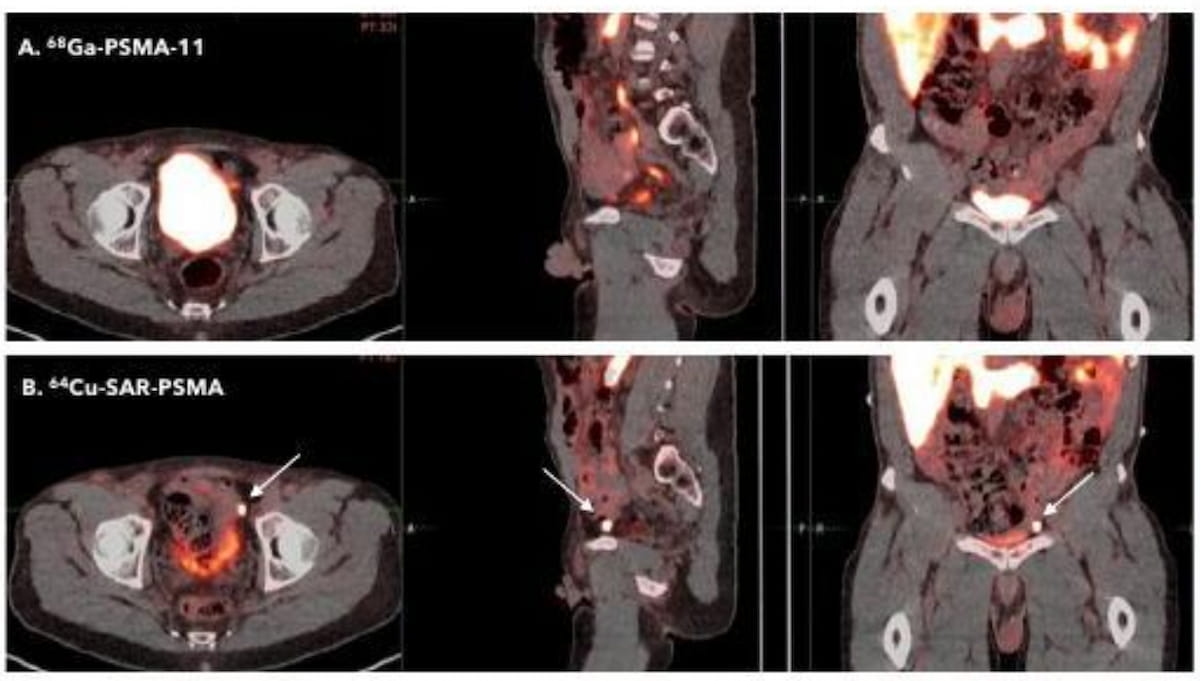Emerging PSMA PET Agent May Offer Improved Detection of Prostate Cancer
The PSMA PET agent 64Cu SAR-bisPSMA detected a higher number of prostate cancer lesions and had a significantly higher SUVmax and SUVmean than 68Ga PSMA-11 PET/CT, according to initial data from a prospective multisite study presented at the recent Society of Nuclear Medicine and Molecular Imaging (SNMMI) conference.
Could there be a new standard of care for prostate-specific membrane antigen (PSMA) positron emission tomography (PET) detection of prostate cancer?
In a study that was presented at the recent Society of Nuclear Medicine and Molecular Imaging (SNMMI) conference, researchers compared initial PSMA PET imaging with 68Ga PSMA-11 PET/CT to different dosing regimens of the PSMA PET agent 64Cu SAR-bisPSMA in 30 men with intermediate to high-risk prostate cancer. The study authors noted the dosing cohorts for 64Cu SAR-bisPSMA were 100 MBq, 150 MBq and 200 MBq. All PSMA PET scans were assessed by two blinded readers, according to the study.
The first reader diagnosed 63 prostate cancer lesions with 64Cu SAR-bisPSMA versus 51 lesions with 68Ga PSMA-11 PET/CT across all cohorts, and the second reader detected 34 lesions with 64Cu SAR-bisPSMA in comparison to 25 lesions with 68Ga PSMA-11 PET/CT, according to the phase 1, prospective, multisite study.
The researchers found that use of 64Cu SAR-bisPSMA resulted in a higher median SUVmax for the readers (30.3 and 41.7) in contrast to 68Ga PSMA-11 PET/CT (13.5 and 14.9). The study authors also noted that 64Cu SAR-bisPSMA had a significantly higher SUVmean (21.2 vs. 9.1 for the first reader and 28.4 vs. 9.94 for the second reader) and higher median tumor-to-background (TBR) ratios (53.6 vs. 24.3 for the first reader and 78.4 vs. 24.7 for the second reader) in comparison to 68Ga PSMA-11 PET/CT.
Noting that 64Cu SAR-bisPSMA may offer “improved tumor uptake and retention compared to PSMA monomers,” researchers found that the PSMA PET agent had significantly higher SUVmax and SUVmean in comparison to 68Ga PSMA-11 in a recent study. (Images courtesy of the Society for Nuclear Medicine and Molecular Imaging.)

“More lesions were detected, and lesions exhibited higher SUVmax, SUVmean and TBR by 64Cu SAR-bisPSMA compared to 68Ga PSMA-11 in men being staged with intermediate- and high-risk (prostate cancer),” wrote study co-author Louise Emmett, M.D., the director of the Department of Theranostics and Nuclear Medicine at St. Vincent’s Hospital in Sydney, Australia, and colleagues.
(Editor’s note: For related content, see “Is Pre-Imaging Biopsy Necessary for Prostate Cancer Staging in Elderly Patients?,” “Utilizing AI for Quantitative Assessment of Prostate Cancer Recurrence” and “Emerging PET Radiotracer May Offer Multiple Advantages in Detecting Prostate Cancer.”)
In contrast to other PSMA agents that have a single targeting functional group, the study authors said a key advantage of 64Cu SAR-bisPSMA is two PSMA-targeting functional groups.
“This can lead to improved tumor uptake and retention compared to PSMA monomers, which may be highly relevant in patients with suspected disease or suspected recurrence where the detection of lesions may lead to a change in management,” noted Emmett and colleagues.
(Editor’s note: For additional content and video interviews from the SNMMI 2023 conference, visit https://www.diagnosticimaging.com/conferences/snmmi .)
Clarity Pharmaceuticals, the developer of 64Cu SAR-bisPSMA, is reportedly planning to initiate a prospective phase 3 study of the agent later in 2023.
Reference
1. Lengyelova E, Wong V, Lenzo N, Parker M, Emmett L. Comparison of PET/CT in subjects with confirmed prostate cancer using 64Cu SAR-bisPSMA and 68Ga PSMA-11. Poster presented at the Society of Nuclear Medicine and Molecular Imaging (SNMMI) 2023 Annual Meeting, June 24-27, 2023, Chicago. https://am.snmmi.org/iMIS/SNMMI-AM?utm_source=dropdown&utm_medium=website&utm_id=AM2022&navItemNumber=581
What New Research Reveals About Novice Use of AI-Guided Cardiac Ultrasound
April 4th 2025In a study recently presented at the American College of Cardiology (ACC) conference, researchers found that novice use of AI-guided cardiac ultrasound after an AI-enabled electrocardiogram increased the positive predictive value for reduced left ventricular ejection fraction (LVEF) or aortic valve stenosis by 33 percent.
GE HealthCare Debuts AI-Powered Cardiac CT Device at ACC Conference
April 1st 2025Featuring enhanced low-dose image quality with motion-free images, the Revolution Vibe CT system reportedly facilitates improved diagnostic clarity for patients with conditions ranging from in-stent restenosis to atrial fibrillation.
New AI-Enabled Portable Ultrasound May Facilitate 50 Percent Reduction in Cardiac Imaging Scan Time
March 28th 2025Artificial intelligence (AI)-powered measurement capabilities provide key features with the Compact Ultrasound 5500CV device, which was unveiled at the American College of Cardiology (ACC) conference.
GE HealthCare Launches PET MPI Agent Flyrcado at ACC Conference
March 28th 2025The positron emission tomography myocardial perfusion imaging (PET MPI) agent, which offers a significantly higher half-life than other cardiac PET agents, was recently granted pass-through payment status by CMS that will go into effect on April 1, 2025.
New Collaboration Offers Promise of Automating Prior Authorizations in Radiology with AI
March 26th 2025In addition to a variety of tools to promote radiology workflow efficiencies, the integration of the Gravity AI tools into the PowerServer RIS platform may reduce time-consuming prior authorizations to minutes for completion.